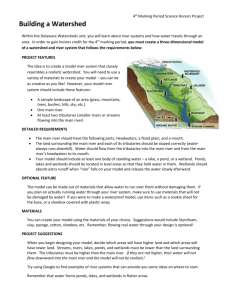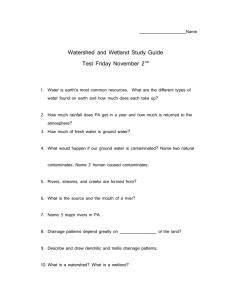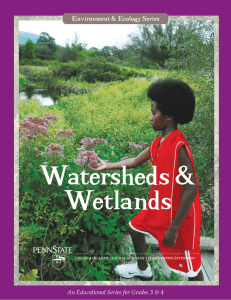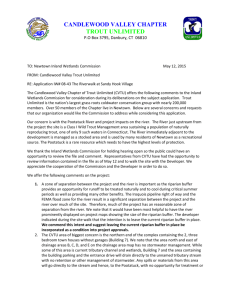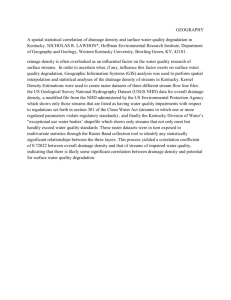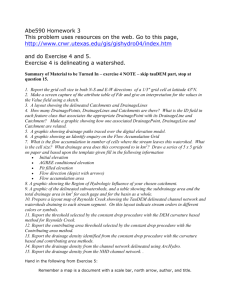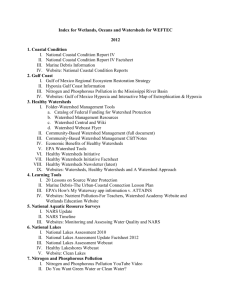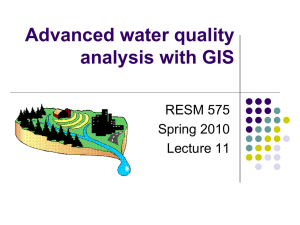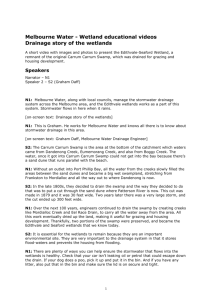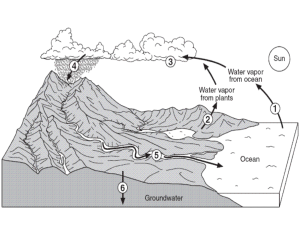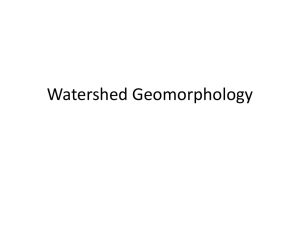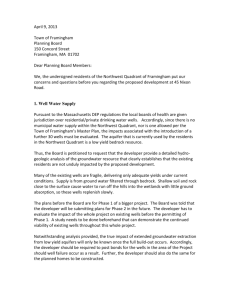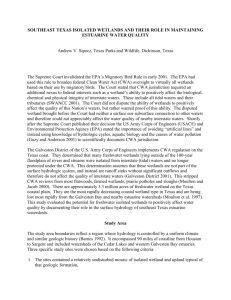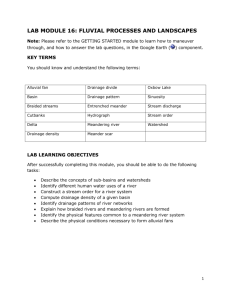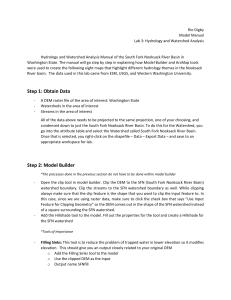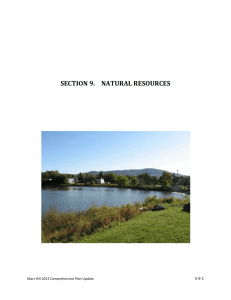Water II Name PowerPoint Wrkst. Section Runoff contributes water to
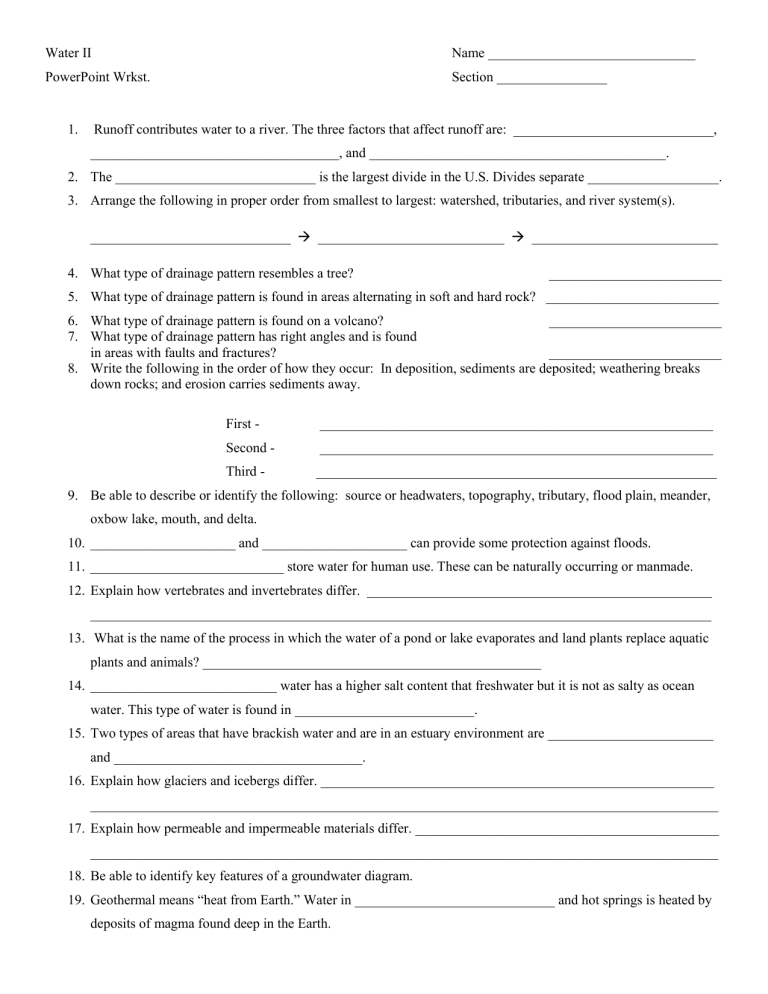
Water II
PowerPoint Wrkst.
Name ______________________________
Section ________________
1.
Runoff contributes water to a river. The three factors that affect runoff are: _____________________________,
____________________________________, and ___________________________________________.
2.
The _____________________________ is the largest divide in the U.S. Divides separate ___________________.
3.
Arrange the following in proper order from smallest to largest: watershed, tributaries, and river system(s).
_____________________________ ___________________________ ___________________________
4.
What type of drainage pattern resembles a tree? _________________________
5.
What type of drainage pattern is found in areas alternating in soft and hard rock? _________________________
6.
What type of drainage pattern is found on a volcano? _________________________
7.
What type of drainage pattern has right angles and is found in areas with faults and fractures? _________________________
8.
Write the following in the order of how they occur: In deposition, sediments are deposited; weathering breaks down rocks; and erosion carries sediments away.
First - _________________________________________________________
Second -
Third -
_________________________________________________________
__________________________________________________________
9.
Be able to describe or identify the following: source or headwaters, topography, tributary, flood plain, meander, oxbow lake, mouth, and delta.
10.
_____________________ and _____________________ can provide some protection against floods.
11.
____________________________ store water for human use. These can be naturally occurring or manmade.
12.
Explain how vertebrates and invertebrates differ. __________________________________________________
__________________________________________________________________________________________
13.
What is the name of the process in which the water of a pond or lake evaporates and land plants replace aquatic plants and animals? _________________________________________________
14.
___________________________ water has a higher salt content that freshwater but it is not as salty as ocean water. This type of water is found in __________________________.
15.
Two types of areas that have brackish water and are in an estuary environment are ________________________ and ____________________________________.
16.
Explain how glaciers and icebergs differ. _________________________________________________________
___________________________________________________________________________________________
17.
Explain how permeable and impermeable materials differ. ____________________________________________
___________________________________________________________________________________________
18.
Be able to identify key features of a groundwater diagram.
19.
Geothermal means “heat from Earth.” Water in _____________________________ and hot springs is heated by deposits of magma found deep in the Earth.
20.
Classify each of the following as point source or nonpoint source pollution:
Fertilizers from farms _________________________________
A fabric factory releases green dye into a stream
Cars leak motor oil on the roads of America
A slaughterhouse dumps animal remains in a river
_________________________________
_________________________________
_________________________________
A pesticide plant releases old pesticides in a creek
The Susquehanna carries sediment to the ocean
21.
What is the largest watershed in PA?
22.
What is the smallest watershed in PA?
_________________________________
_________________________________
_________________________________
_________________________________
23.
How many watersheds are in PA?
24.
Into which ocean do PA watersheds drain?
_________________________________
_________________________________
25.
In which watershed do we live? _________________________________
26.
How many acres of wetlands existed in the U.S. over 400 years ago? ____________________
27.
Human activities that affect wetlands include:
Agriculture (use of pesticides and fertilizers, livestock waste, drainage, irrigation ditches, etc.)
Urbanization and Construction (runoff-creating concrete, drainage, building of roads and bridges, levees, etc.)
Mining
Industry (chemical use, water intake, habitat loss, etc.)
Waste Disposal (landfills, sewage, sludge, etc.)
28.
Study notes on Stream Biology, Factors that Affect Freshwater Ecosystems, and the Functions of Wetlands.
29.
The following are notes regarding the roles of wetlands.
Role
Habitat
Description
80% of all amphibians live there and 35 % of endangered or threatened species; home to bacteria; protists, plants, animals
Food Factories
High productivity rate, primarily from plants; decomposition provides food for bacteria and protists, fungi, and invertebrates.
Spawning Grounds and
Nurseries
Used for reproduction by amphibians and waterfowl (ducks, geese, herons, etc.), fish, etc.; coastal areas used by shellfish (crabs, crayfish, and so on).
Cycling Nutrients
Buffer Zones
Pollution Control
Plants undergo photosynthesis and release oxygen; oxygen and plants used by consumers; recycle carbon, oxygen, nitrogen, and phosphorus.
Act as sponges during flooding; “natural sponges” absorb runoff; slowly release water; in coastal areas, prevent erosion, absorb forces from storms.
#1 water pollutant in Pennsylvania
sediment; wetlands slow water movement to reduce flow of sediment; absorb excess carbon, a greenhouse gas, to aid in global warming
EEP, Ch. 1 – Watersheds and Wetlands
Study Materials
Name ______________________
Section ______
1.
___Calcium___ is a mineral that causes hard water.
2.
A stream’s gradient is steeper ____upstream____.
3.
High levels of nutrients ________decrease___ oxygen levels.
4.
True or False: Many wetlands have been lost because of mining.
5.
Urban runoff can increase or decrease salinity. (Cross out the incorrect word.)
6.
Dams are vulnerability indicators of a watershed because they cause changes in _____temperature____ and ____salinity_____.
7.
___Trees____ and ____shrubs___ are plants which dominate swamps.
8.
Wildlife in first-order streams includes _____insects______ and ___small fish___. Higher order streams have ___game fish______ and ___plants____.
9.
Gravel, sand, and boulders are found in the ____bed___ load.
10.
Complete the following.
Match the following types of drainage patterns with the description.
_D___ Trellis A. Tributaries for at right angles.
_C___ Dendritic B. Found on cone-shaped features.
_A___ Rectangular C. Tree-like pattern.
_B___ Radial D. Parallel tributaries form here
11.
Wetlands can function in the following ways: a.
Filter out impurities and pollution. b.
Absorb excess water and release it slowly (preventing floods). c.
Provide habitat.
12.
Vegetation decreases runoff and decreases erosion.
13.
Wetlands provide food for food webs.
14.
Wetland plants retain carbon rather that releasing it into the atmosphere.
15.
Urban areas have a great deal of runoff because of pavement and concrete.
16.
Decomposition occurs more quickly in water where circulation is poor.
17.
Strong winds can affect streams by carrying sediments.
18.
Volcanoes can affect streams because of the dust that is created and the heat that is released.
19.
Buffers along streams, i.e. plants, help control temperatures in a stream.
20.
What are the sub-basins of the Susquehanna watershed?
21.
What are the processes of the water cycle?
EEP - Ch. 1, p. 15-18
Summary - Factors That Affect Freshwater Ecosystems Key
Stream Order
Rills larger
Name ______________________________
Section __________
tiny channels; combine to form streams; 1 st order are the smallest. 3 rd and 4 th are
Temperature
Temperature differences caused by: velocity, depth, and circulation of water; seasonal changes; temperature affect organisms in stream
Current and Velocity
Streams and rivers have unidirectional currents (one direction); decrease in slope decrease velocity; velocity slower at surface and at bed; most rapid in middle
Substrate
Sunlight
Substrate –material organism live in, on , or near; contains organic and inorganic matter; insect larvae, bullheads, algae can be found here
Lack of sunlight adversely affects ecosystems; aquatic plants require sunlight for photosynthesis; sunlight cannot reach to great depths; sunlight affects biodiversity
(variety of organisms)
Turbidity
Dissolved Solids
Turbidity clarity of water; turbidity increases with snow melt, high water volume, temperature (warm water increases plankton growth)
Dissolved load
magnesium, calcium, sodium, potassium, etc.; nitrogen and phosphorus stimulate plant growth causing algal blooms
deplete O
2
level
Dissolved Gases
Gases include carbon dioxide and oxygen (CO
2
and O
2
); O
2
is the most important in stream diversity
Oxygen
Carbon Dioxide
Organic Matter pH
O
2
enters water from air; as temperature of water increases, O
2
entering water decreases; decrease current velocity, decrease O
2
in water; photosynthesis increases O
2
; decomposition decrease O
2
levels
Two sources of CO
2
in water
atmosphere and groundwater systems; other sources
decomposition and respiration; plants use CO
2
in photosynthesis
Organic matter used for food; examples larvae, plankton, algae, wood, etc.; increase organic matter, decrease O
2 levels; lack of food organisms migrate to other areas if there are insufficient amounts of organic matter
Scale
0-14; 7 = neutral; <7-0 = acid, >7-14 = basic; source of acid in PA
acid rain, minerals in rock, and coal mine drainage; organisms can be sensitive to pH
